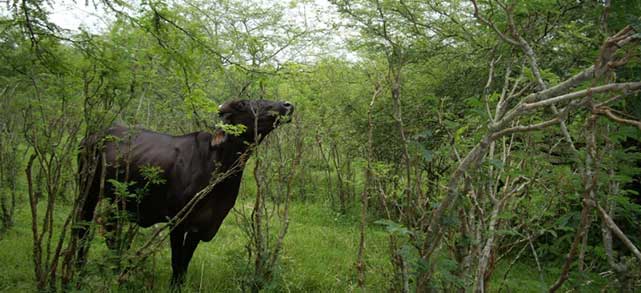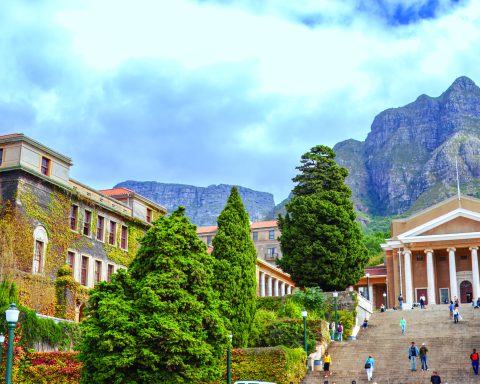Imagine an overgrown perennial garden. Impenetrable, shrubby bushes knit themselves together in long rows. Grasses reach chest high. Native hardwood trees hog the perimeter.
But this dense, green expanse is not a garden. It is a new kind of forested “pasture” that Latin American farmers are using to raise more cattle on less land while producing twice the milk and meat per acre. And Colombian researcher Enrique Murgueitio, who earned his doctorate in veterinary medicine and animal husbandry, is leading the way into this new, more sustainable farming landscape.
At the Cali, Colombia-based Center for Research in Sustainable Systems of Agriculture (CIPAV), where Murgueitio is executive director, farmers from throughout Latin America learn how to replace wide expanses of conventional pasture stubble with agro-forestry methods that use 4,000 plants per acre—a mosaic of trees, forage shrubs, tropical grasses and groundcover—to feed their cows. To date, around 74,000 acres of land in Latin America have been transformed into this intensive, silvo-pastoral system of grazing, and raising cattle with agro-forestry is central to Colombia’s National Development Plan for cattle ranching. The plan seeks to reduce pasture land from 94 million acres to 70 million acres while increasing cattle numbers from 23 million head to 40 million by 2019.
While much of Brazil and China are now ramping up their cattle production using industrial agricultural systems like feedlots, Murgueitio argues that a simpler approach makes better economic and environmental sense. “The [silvo-pastoral] system coincides with Asian principles, which are more holistic and simple in life,” says Murgueitio, who became interested in the concept of “fodder trees” after reading an article about a Sri Lankan project while he was in college.
Most of the cattle that thrive in Colombia—frequently a mix of Brahmin and South American cattle—have a long history of withstanding the heat and pests of tropical regions. But finding out how to feed them well, using a mixture of trees and shrubs, is Murgueitio’s job.
A new climate for cattle ranching in Colombia
Standing at a local ranch amid low-slung trees, special varieties of leguminous shrubs, dense tropical grasses, and groundcover like peanuts, Murgueitio takes a deep breath of air. Tropical midday sun beats down on nearby grassland steps away, but it’s five to 10 degrees cooler amid the light shade of the silvo-pastoral grazing area.
The soil underneath Murgueitio’s feet is rich and fertile, an important component of the grazing at this ranch run by Carlos Hernando Molina, where the roots of the resilient grazing system go back more than 20 years. During that time Molina has replaced 220 acres of open pastureland with trees, shrubs and bushy vegetation. Today, Molina’s dairy cattle are able to be milked twice a day, doubling his production of milk, and he can graze twice as many cattle per pasture because the forage is so dense compared with conventional grassland.
“The advantage to this system is that the benefits to the environment and to production occur simultaneously,” says Murgueitio.
In Colombia, where cattle inhabit 85 percent of the agricultural area, traditional pastures have contributed to soil degradation and deforestation and, in dry areas, have hastened desertification. But Murgueitio’s new paradigm is emerging as a solution to improving resilience to climate change, as well as improving food security and biodiversity conservation.
“We are building systems that can be applied to traditional ways of production that not only take into account the value of the livestock production but also justice, equity, equality, democracy, solidarity and being respectful with nature,” he says. “A silvo-pastoral system is sustainable, and in that way is respectful to the next generation.”
The simplicity of the silvo-pastoral system, however, doesn’t mean it lacks strong science backing. Just the opposite. The trees absorb the carbon and retain humidity in the pasture canopy; the root systems of the shrubs “fix” or concentrate nitrogen up to three feet underground, which helps fertilize the soil naturally; and the vegetation helps the soil retain moisture. Dung beetles work quickly to draw animal waste underground and enrich soil; in a traditional open pasture the dung would remain on the surface, attracting flies. Because the animals eat more nutritious plants, they gain weight more quickly, produce more milk and can be milked twice daily, and their ruminant stomachs produce up to 20 percent less methane.
In Colombia, planting this kind of silvo-pastoral system costs between $1,000 and $2,000 per hectare, depending on the mixture of trees and shrubs. Farmers usually achieve a 100 percent return on investment within two years due to increases in milk production and weight gain in their cattle, according to Murgueitio’s analysis.
Silvo-pastoral goes global
Livestock and their food needs currently take up 30 percent of land globally, according to the United Nations’ Food and Agriculture Organization (FAO). And meeting projected demands for milk and animal protein globally without expanding pasture will require production to grow by more than 80 percent by 2050, say experts from the World Resources Institute (WRI). Intensive silvo-pastoral systems, however, show good promise of getting close to that in tropical regions, according to Tim Searchinger, a senior fellow at WRI and research scholar at Princeton University.
Thanks to policy incentives from the Colombian government and the stamp of approval from the country’s national cattlemen’s association, FEDEGAN, along with freely available technical assistance from CIPAV, farmers from Mexico to Brazil are now using Murgueitio’s sustainable system. For example, “there is a network of intensive silvo-pastoral systems in Mexico that works in 16 states, with 10,000 hectares planted in only four years,” he says. Pilot projects also are testing the system in Argentina, Brazil, Nicaragua, Panama and Venezuela.
Right now the system of high-density trees and shrubs integrated with animals is mostly designed for tropical regions, but Murgueitio says the research can extend to other places such as Canada, the United States, Spain, Sweden, Vietnam, Cambodia, India, Kenya, Nepal and Honduras, among others. CIPAV is poised to further scale up its leadership in developing intensive silvo-pastoral systems now that it participates in an international network for sustainable livestock, a project led by the FAO.
Murgueitio says CIPAV’s future research plans include sustainable livestock grazing systems for the subtropics in Chile and Mexico, as well as new practices to capture “green water” (precipitation that stays on top of the soil), new plants such as fodder cactus that will work in semi-arid areas, and agro-forestry grazing systems that will provide food for water buffaloes, goats and sheep (for wool production).
These types of sustainable systems will especially help small farmers withstand the effects of a warming planet, he adds. “Small-scale farmers don’t have all the tools to fight against climate change,” Murgueitio says, and resilient systems are their best weapons to combat the effects of global warming.
Travel funding for this story was provided by a grant from the Solutions Journalism Network.
This article originally appeared on FutureFood2050.







